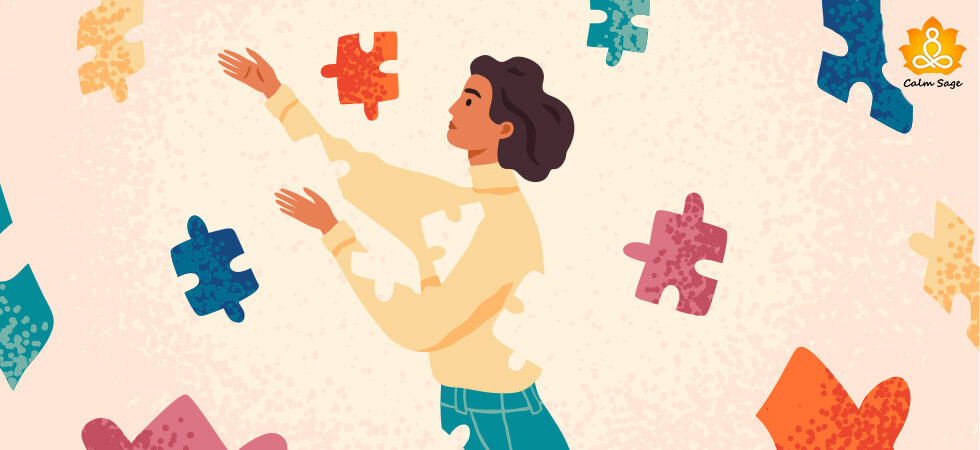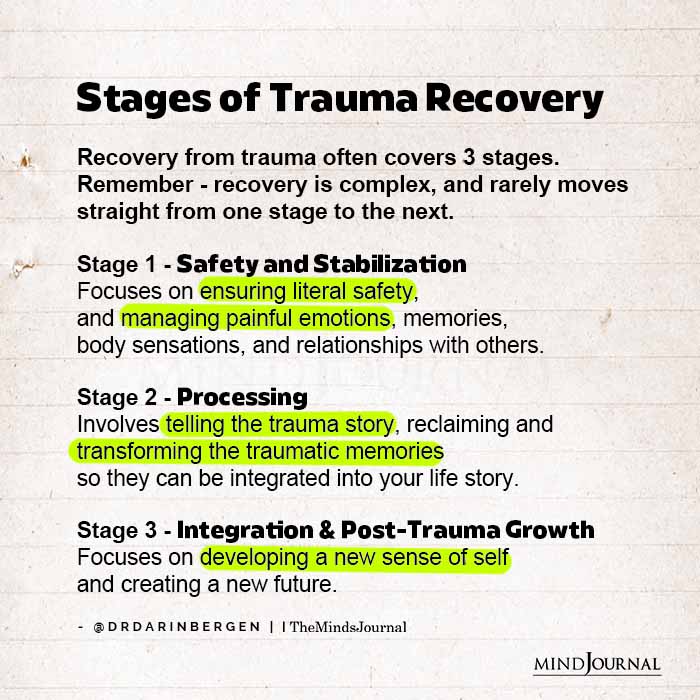The 3 Stages of Trauma Recovery (And What to Remember When Healing)

One of the most painful experiences a human can experience is trauma. Trauma can leave lasting scars on our mental and emotional health even after the wound has been stitched up years ago. Now, when I speak about trauma, I’m not just talking about war, accidents, or abuse. A traumatic event could be an almost fatal car accident and it could be as subtle as childhood neglect.
When the wounds from trauma linger on your psyche and continue to bleed – emotionally, of course – then you might even experience post-traumatic stress disorder (PTSD).
Trauma can be challenging to live with as it tends to change your views on the things and events around you as well as who you are. This painful experience often influences your future, your current life, and your relationships.
Healing from trauma can take some time and we almost always forget that like any other wound healing, recovery from trauma isn’t simple or pretty. It’s a journey filled with lots of twists and uneven turns that may make you stumble now and then.
It’s OK though, with the right steps and knowledge, you’ll get there. Today, I’ll help you understand the 3 stages of trauma recovery as proposed by Judith Herman, one of the leading experts on trauma and abuse.
The 3 Stages of Trauma Recovery

Stage 1: Safety and Stabilization
The first stage of trauma recovery is Safety and Stabilization wherein a sense of stability and safety is established. You can think of this stage as building a strong foundation upon which your healing process will begin. Trauma tends to leave us feeling unsafe, overwhelmed, and vulnerable, so in this stage of trauma recovery, the focus is on regaining control over your life.
For example; You survive a natural disaster. At first, you may feel on edge, fearing another accident. To feel safe, you might seek refuge with family and friends or seek professional help.
So here, at this stage, you focus on developing healthy coping strategies that can help reduce distress, calm your nerves, and add to your sense of safety and security.
Some strategies you can try in this stage can include;
- Practicing meditation to stay grounded in the present moment
- Psychotherapy
- Self-care techniques
- Self-soothing techniques, etc.
Did you know that there have been studies that report that people with a strong support system at the first stage of trauma recovery are more likely to heal effectively? Therapy approaches such as cognitive-behavioral therapy (CBT) might also help effectively recover and regain control over your thoughts and emotions.
Stage 2: Remembering and Mourning
The second stage of trauma recovery is Remembering and Mourning wherein you confront and process your traumatic memories. Now, this can be challenging as it involves relieving painful memories and remembering your traumatic experiences. However, this stage is an integral part of the recovery process as it helps release the emotional baggage that trauma comes with.
For example; if you were a victim of a violent crime, then you may need to recall your experiences to a therapist. When you do so, you can begin to process your feelings and mourn what you’ve lost. You might also go through the stages of grief in this process. This isn’t about dwelling on the negative experiences but acknowledging the pain to move forward.
This stage of trauma recovery may include;
- Reframing your beliefs
- Processing trauma through the five stages of grief
- Connecting with support groups
- Processing traumatic grief
In a study, Eye Movement Desensitization and Reprocessing therapy (EMDR) has been found effective in processing trauma memories and reducing their intensity. You can talk to a therapist about how EMDR might work and help you with your traumatic experiences and memories.
Stage 3: Reconnection and Integration
The third and final stage of trauma recovery is Reconnection and Integration wherein you learn how to reconnect with yourself and your loved ones as well as allowing your traumatic experiences into your life’s story. It’s the stage where you rebuild your sense of purpose and find new ways to live with trauma.
For example; Now that you’ve survived a traumatic event, you may start to rediscover your interests and strengths. You might feel like volunteering for a cause that’s close to your heart, creating new relationships, or even finding a new meaning to life beyond your trauma.
This stage is where you ask yourself, “What next?”; where you realize that your trauma doesn’t define your life or your future. Here you begin to set new goals for yourself and find ways to reconnect with others in your life.
Research shows that people who reach this final stage of trauma recovery often report an increased sense of self-growth and resilience. And why not? After all, finding life’s purpose and feeling a sense of belonging can be effective tools for healing from trauma.
Things to Keep in Mind When Healing From Trauma
When you’re recovering from trauma, there are a lot of twists and turns that you might need to navigate through, so to help you out, here are some things to remember when healing from trauma;
1. Seek professional support:
Know that therapists and counselors trained in trauma recovery can help you and offer guidance and support that can aid you in your trauma recovery. You don’t have to do all of it alone and be overwhelmed. Seek help, if you need it.
2. Build a support network:
Try to surround yourself with friends and family who are supportive and understanding of your recovery and can offer emotional support when you’re in the recovery stage. Again, having a support system can help you heal better and faster.
3. Don’t neglect self-care:
While you’re focusing on trauma recovery, don’t forget to take care of yourself. Engage in activities that allow you to emotionally and physically heal such as meditation, exercising, journaling, creative self-expression, and more.
4. Be patient and kind to yourself:
Know that healing takes time and there might come a time when you’ll face setbacks and challenges too difficult to navigate. During those times, remember to be forgiving and kind to yourself. Healing is not linear, so be patient.
5. Give group therapy a try:
If you wish, you can connect with others through group therapy. Connecting with people who have been through similar experiences and trauma can help you feel a sense of community, making your healing more comforting and smoother.
Wrapping Up…
Judith Herman’s 3 stages of trauma recovery help us understand that recovery is a process that requires a sense of safety, remembering and processing, and reconnecting with yourself while learning to integrate your trauma into your life. The Judith Herman trauma recovery model offers a roadmap for trauma survivors to regain control of their lives and find hope through recovery.
No matter what stage of recovery you are at, remember that healing is a unique journey and there’s no need to rush your healing. After all, healing isn’t going to happen in a straight line.
Understanding these stages of trauma recovery and what they entail can help you set out on your healing journey and regain your sense of self. You are not alone and there’s a world of hope beyond your trauma, so keep moving forward – one step at a time!
Was this article helpful? Let me know in the comments below. You can also share this article with your friends and family to help them understand the stages of trauma recovery. Don’t forget to give us a like and follow us on our social media for more informational content.
Take Care!




















